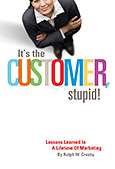Tactics Without Strategy Will Fail
Sun Tzu, the 500 BC Chinese author of The Art of War, wrote:
“Tactics without strategy is the noise before defeat.” The same can be said of marketing. Undertaking ad, PR or online tactics without a strategy is a recipe for failure.
All successful marketing processes or programs should begin the same way – with research and analysis to create a strategy. The result is a strategic plan or direction. Developing, testing and implementing the tactics to achieve the strategic direction comes later.
At my agency, Crosby Marketing Communications, we follow a marketing process we call CORE. The letters stand for: Capture critical data; Orchestrate strategies; Rollout communications; and Evaluate results. CORE is a step-by-step guide that evaluates the client’s brand promise, defines target audiences, establishes key messages, shapes an integrated communications plan, establishes integrated tactics, and measures results. We’ve seen this process bring order and efficiency to marketing efforts, maximizing the odds for achieving client’s goals and objectives.
The first step, capture critical data, is the mandatory research and analysis phase, and it must focus on the customer. This is the stage in which you gather information about customers, determine their wants, needs and preferences and decide what messages and media will move those customers to take the action you seek.
Most important, this is the time to listen to your customers. Research shows that the most successful companies are the ones that are better listeners.
One way to find out what customers want or need is to ask them. Using surveys, focus groups, one-on-one interviews, etc., you can periodically determine your customers’ needs and react to satisfy them. These information-gathering techniques have a number of ancillary benefits:
- Keeping in contact and building an ongoing relationship with the customer.
- Discovering problem areas or mistakes you may be making.
- Creating sales opportunities.
- Building a customer database.
In the online age, you should monitor the Internet and social media for customer information. Customers often comment online about a company’s products, services or activities. It’s important to monitor their comments whether you use a paid monitoring service or a free one such as “Google Alerts.”
No matter how you gather your customer information, the more you learn the better you will be able to calculate a winning strategy.
As Sun Tzu said:
“The general who wins the battle makes many calculations in his temple before the battle is fought. The general who loses makes but few calculations beforehand.”
###

 Businesses often are started by entrepreneurs with an idea, a product or service, or an expertise. Many of them fail, not because the idea or product isn’t good, but because their attention is overwhelmingly directed internally – e.g., what goes into the product – when they should focus externally, always reminding themselves:
Businesses often are started by entrepreneurs with an idea, a product or service, or an expertise. Many of them fail, not because the idea or product isn’t good, but because their attention is overwhelmingly directed internally – e.g., what goes into the product – when they should focus externally, always reminding themselves:
